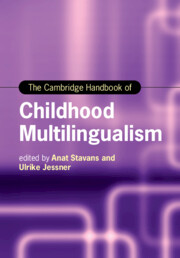Book contents
- The Cambridge Handbook of Childhood Multilingualism
- Cambridge Handbooks in Language and Linguistics
- The Cambridge Handbook of Childhood Multilingualism
- Copyright page
- Contents
- Figures
- Tables
- About the Editors
- Contributors
- Acknowledgments
- Multilingualism Is Not Bilingualism +1: An Introduction
- Part One Becoming and Being a Multilingual Child
- Part Two Cognition and Faculties in Multilinguals
- Part Three Family Language Policy
- Part Four Language(s) and Literacy of Multilingual Children through Schooling
- 15 Being Plurilingual in the Language Classroom
- 16 Literacy Development in the Multilingual Child: From Speaking to Writing
- 17 Attitudes, Motivations, and Enjoyment of Reading in Multiple Languages
- 18 Growing Up with Multilingual Literacies and Implications for Spelling
- 19 Assessing Multilinguals
- 20 Plurilingualism and Young Children’s Perspectival Cognition
- Part Five Socialization in Childhood Multilingualism
- Part Six Multilingual Children’s Landscape
- Subject Index
- Country Index
- Language Index
- References
15 - Being Plurilingual in the Language Classroom
from Part Four - Language(s) and Literacy of Multilingual Children through Schooling
Published online by Cambridge University Press: 18 August 2022
- The Cambridge Handbook of Childhood Multilingualism
- Cambridge Handbooks in Language and Linguistics
- The Cambridge Handbook of Childhood Multilingualism
- Copyright page
- Contents
- Figures
- Tables
- About the Editors
- Contributors
- Acknowledgments
- Multilingualism Is Not Bilingualism +1: An Introduction
- Part One Becoming and Being a Multilingual Child
- Part Two Cognition and Faculties in Multilinguals
- Part Three Family Language Policy
- Part Four Language(s) and Literacy of Multilingual Children through Schooling
- 15 Being Plurilingual in the Language Classroom
- 16 Literacy Development in the Multilingual Child: From Speaking to Writing
- 17 Attitudes, Motivations, and Enjoyment of Reading in Multiple Languages
- 18 Growing Up with Multilingual Literacies and Implications for Spelling
- 19 Assessing Multilinguals
- 20 Plurilingualism and Young Children’s Perspectival Cognition
- Part Five Socialization in Childhood Multilingualism
- Part Six Multilingual Children’s Landscape
- Subject Index
- Country Index
- Language Index
- References
Summary
This chapter presents some of the complex issues relating to the teaching/ learning of (emergent) pluringual children within the context of formal education. In addition to defining key concepts, the chapter exemplifies research findings by giving voice to the learner through the inclusion of short extracts from a personal testimony in which early education experiences in relation to plurilingualism are discussed. When the language(s), cultural codes and expectations at school differ from those at home, both teachers and learners can feel destabilized. Inadequate teacher education about plurilingualism leaves a void all too easily filled with misguided and unhelpful practiced language policies, fuelled by ideologies rather than research. This chapter discusses the consequences of language (de)legitimization, focusing on the complex dynamics and interplay of language, power and relationships. It examines how schools and their staff acknowledge and build on or ignore and impede plurilingual children’s knowledge and skills development.
Keywords
- Type
- Chapter
- Information
- The Cambridge Handbook of Childhood Multilingualism , pp. 355 - 375Publisher: Cambridge University PressPrint publication year: 2022
References
- 1
- Cited by

